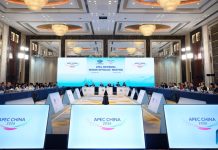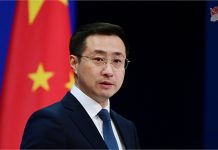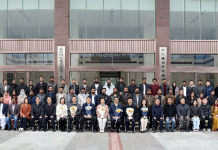
‘Venezuela is going to the Moon!” Gabriela Jimenez, Venezuela’s Vice President and Minister of Science and Technology, wrote in an X (then known as Twitter) post in July, after the country became the first in the Americas to join the China-initiated International Lunar Research Station program.
When meeting with visiting Venezuelan President Nicolás Maduro Moros in Beijing on September 13, Chinese President Xi Jinping congratulated the country for deciding to join the program.
Noting China attaches great importance to the development of relations with Latin American and Caribbean (LAC) countries and that next year will mark the 10th anniversary of the China-Community of Latin American and Caribbean States (CELAC) Forum, Xi said China is ready to work with Venezuela and other countries in the region to promote cooperation and build a community with a shared future.
Back in January, when addressing the Seventh Summit of the CELAC in Buenos Aires, Argentina, via video link, Xi called LAC countries important members of the developing world and said they take an active part in global governance and make important contributions to it. CELAC has grown to be an indispensable driving force behind global South-South cooperation, Xi said, adding that the intergovernmental mechanism for dialogue and political cooperation has played an important role in safeguarding regional peace, promoting common development and advancing LAC integration.
“China is ready to continue working with LAC countries to help each other and make progress together, and advocate peace, development, equity, justice, democracy and freedom—the common values of humankind,” Xi said.
In-depth dialogue
Since its inception in 2017, the annual Dialogue Between the Civilizations of China and LAC has promoted exchange between both sides, and has become one of the most influential platforms in this process.
The sixth edition of the forum, the first to be held outside China, took place in Buenos Aires on September 11. It brought together over 100 participants, including government officials, researchers, media representatives, and business leaders. Their discussions centered on exploring new avenues for building a China-LAC relationship characterized by equality, mutual benefit, innovation, openness and benefits for the people.
In his address at the event, Liu Dawei, Vice President of China International Communications Group (CICG), called for joint efforts in implementing the China-proposed Global Civilizations Initiative (GCI) that advocates cultural inclusiveness and mutual learning and creating a model for South-South cooperation.
Widespread public participation is vital to mutual learning between the two civilizations, and subnational cooperation and people-to-people exchange are the cornerstones of exchange and dialogue, said Francisco Resnicoff, Undersecretary for International and Institutional Relations of the City of Buenos Aires.
To provide an example, Resnicoff said Buenos Aires has always valued its interaction and cooperation with cities in China, and has launched distinctive and diverse activities to inject impetus into the China-LAC friendship.
Political engagement, economic exchange and cultural integration constitute the three pillars of dialogue between the civilizations of China and LAC countries, said Martín Unzué, Director of the Gino Germani Research Institute at the University of Buenos Aires.
The forum also featured academic discussions on ways to nurture new driving forces for the China-LAC comprehensive cooperative partnerships as well as approaches to facilitate common development and knowledge sharing between China and LAC countries. The participants called for concerted efforts to implement the GCI and expand bilateral trade, cultural, educational and media exchange to consolidate nongovernmental foundations for friendly cooperation.
Unzué said people in Argentina hope that China and their country can further strengthen coordination in international affairs, deepen practical economic and trade cooperation, and expand cultural and people-to-people exchange.
BRI partners
The fresh juicy cherries hanging low on the branches in the China-Chile Demonstration Farm in Tianjin were part of efforts to introduce the fruit to Chinese consumers some 20 years ago. Through the efforts of Chilean Ambassador to China Luis Schmidt, then Chairman of FedeFruta (the Chilean Fruit Growers Association), the two countries signed an agreement in 1999 to introduce cherry saplings to China.
In 2017, a similar demonstration farm was inaugurated on the outskirts of Santiago, capital of Chile, aiming to introduce Chinese vegetables and other crops to the South American country, as well as to share agricultural technologies.
Introducing China’s advanced wind turbine equipment to Brazil for the first time, the LDB Wind Power Expansion Project was put into operation in the country’s northeastern state of Piauí last year, bringing local people one step closer to green and low-carbon economic development.
These are all telling examples of the cooperation between China and LAC countries.
When speaking at the forum, Carola Ramón, Vice Chairperson-elect of the Argentine Council for International Relations, expressed her hope for strengthened political mutual understanding and trust between China and LAC countries under the China-proposed Belt and Road Initiative (BRI), which aims to boost connectivity along and beyond the ancient Silk Road trade routes. She called for leveraging each other’s economic strengths to elevate exchange and collaboration across all sectors.
In 2022, Argentina and Nicaragua signed memorandums of understanding with China to participate in the BRI. Of the 28 LAC countries that have diplomatic relations with China, 22 now have agreements with China on BRI cooperation.
According to statistics from the General Administration of Customs of China, China has held its position as the second largest trading partner of the LAC region for the past decade. In 2022, bilateral trade reached a new high, exceeding $450 billion for two consecutive years.
The two sides have also explored cooperation on the digital economy. At the Third Ministers’ Meeting of the China-CELAC Forum in 2021, the parties agreed to promote cooperation between governments, enterprises and research institutions in digital infrastructure, communications equipment, 5G, big data, cloud computing, artificial intelligence, smart cities and other fields, so as to promote the intelligent, digital and green development of these industries.
Today, leading Chinese tech firms such as Huawei and ZTE are helping LAC countries achieve digital transformation. Chinese cloud technology is providing secure, efficient and low-cost data storage services for enterprises in these countries.
“LAC countries hope to further integrate their strengths and resources in areas such as technology, energy, education and culture, with the genuine aim of enhancing the wellbeing of the people through development,” said Juan Santarcángelo, a researcher with Argentina’s National Scientific and Technical Research Council and the National University of Quilmes in Buenos Aires.

Further exchanges
Ramón also underscored the importance of expanding people-to-people exchange to consolidate the foundation for Belt and Road cooperation.
Exchange and cooperation between China and LAC countries in media, think tanks and education have been strengthened through the support of closer economic ties, said Li Yafang, President of the CICG Center for Americas at the forum.
China has promoted initiatives including government scholarships, personnel training and political party exchanges, and has launched programs including China-LAC Science and Technology Partnership and the China-LAC Scientist Exchange Program, with scientists from LAC countries visiting Chinese research institutes for short-term exchange programs every year.
By the end of 2022, 46 Confucius Institutes and six Confucius Classrooms had been set up in 23 countries in the LAC region, Li added. Confucius Institutes and Classrooms, named after the ancient Chinese philosopher Confucius (551-479 B.C.), are nonprofit public institutions that help people around the world better understand China by teaching Chinese language and culture at universities, schools, cultural organizations and community centers in their host countries.
During the opening ceremony of the forum, CICG Center for Americas also initiated the Media and Think Tank League of China and LAC Countries with its counterparts. The founding members of the league are 18 media organizations and think tanks from China, Argentina, Brazil, Mexico, Chile and Peru.
By jointly creating platforms for cooperation, the league aims to pool resources and engage in constructive communication, dialogue, joint research and staff training. Members will launch joint programs covering information exchange, content production and sharing, personnel exchange, professional training, academic seminars and research projects.
In response to imbalanced global development and the uneven power of countries to make their voice heard, media organizations should make efforts to promote dialogue and cooperation among civilizations on an equal footing and beneficial to all, said Nicolás Schonfeld, Executive Director at Latin American media platform RED TAL.
“We are teaming up with the intention to promote mutual learning between China and LAC countries, people-to-people connections and friendly development in order to create a brighter future,” Li read out from the league’s joint declaration. “We will strive for a more equal and just international environment for developing countries to make their voices heard. We will work side by side to speak on behalf of world peace and global development.” –The Daily Mail-Beijing Review news exchange item





